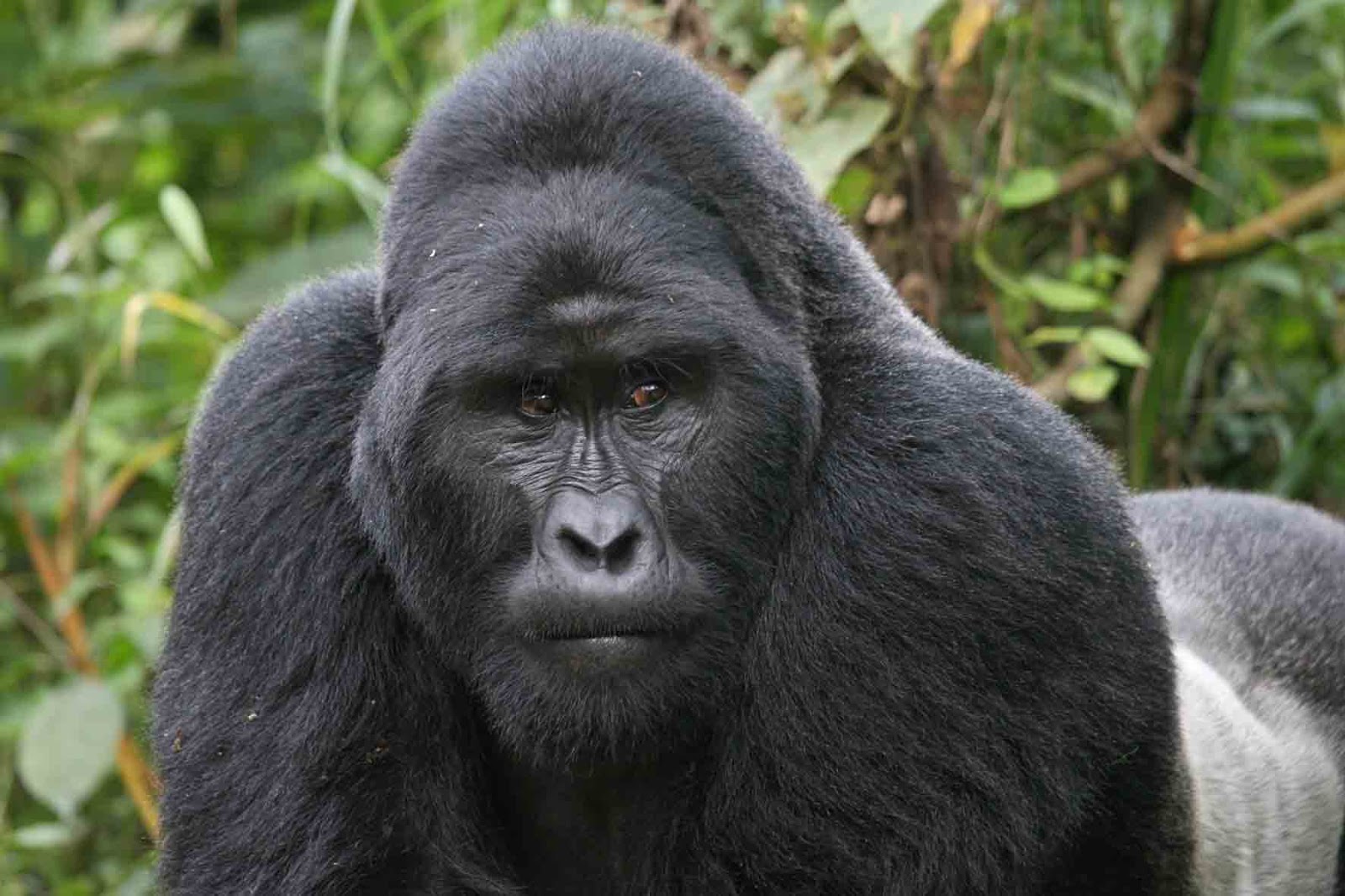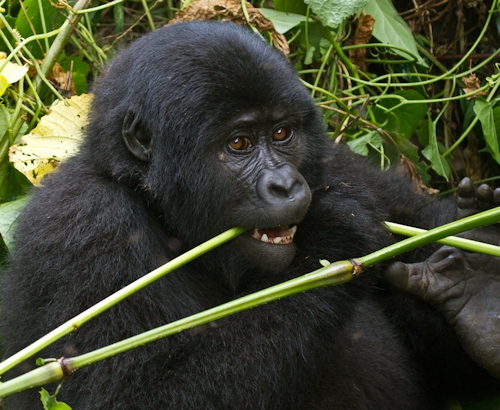Gorilla Trekking

Gorilla trekking is commonly found in the Africa's central rainforests like Kenya's Laikipia Plateau, Uganda and Rwanda. These regions are mainly home for mountain gorillas. There are less than 800 mountain gorillas left in the whole world and this is what makes gorilla trekking safaris unique. Let SP Safari Tours team of experts help you plan a helicopter tour ride into these regions of gorilla's original habitats for a unique life-changing and memorable opportunity!
Gorillas in Rwanda weren’t known about by the western world until 1902. Rwanda then, was under a German colony. Captain von Berenge was mountaineering Mount Sabinyo on the side of Rwanda together with his friends and at 9300 foot-level where they camped and spotted a group of Mountain Gorillas and there he shot 2 of them although managed to retrieve just one. The victim was a young-male approximately five years of age, not too big at 220 pounds, however larger than all apes the Germans had ever seen. The Bones plus skin were later forwarded to Berlin and there it was acknowledged as a mountain gorilla.
The Belgians then launched a Mountain Gorilla preservation’s program and later followed the English who did it in Uganda. Since then, no one was allowed to receive visitors to see these Mountain Gorillas in Uganda. Later, Within Kisoro, Walter Baumgärtel was offered permission to establish visits for tourists to his beautiful Traveller’s Rest Inn, a facility where up to date you can stay within Uganda. Baumgärtel wrote an interesting Book “Up among the Mountain Gorillas” which actually is about his personal encounters with the tranquil giant apes in southern Uganda. It is a great book with reference to a man, the attractiveness of the Uganda’s countryside and an inn, and generally about the fascinating Mountain Gorillas and Uganda gorilla safari. Actually Dian Fossey lived there on a frequent basis similar to George Schaller and many other renowned tourists. If you have watched the movie, "Gorillas in the mist", then this tour will come alive in you.
The mountain gorillas are actually a subspecies known as Gorilla beringei beringei. These can only be found in the wilderness of the Virunga highlands of Rwanda within Volcano Park including Bwindi Impenetrable Forest National Park as well as Mgahinga Gorilla National Park in Uganda, and the Virunga National Park found in the Democratic Republic of Congo. These parks are found only 48 km from each other. Within Uganda as well as Rwanda these parks can be accessed easily, while it is difficult to access the parks in the Democratic Republic of Congo due to the rebel activities and therefore probable threat to the lives of visitors.
Uganda holds close to half of the total population of the mountain gorillas in the whole world, and the majority of them live in Bwindi Impenetrable Forest, whereas the others are found in Mgahinga Gorilla Park, which at times cross over to Rwanda. Fortunately the Gorillas have started to grow again in numbers because of the protection they are offered from the government of Uganda which also included efforts of the adjacent communities to the parks to whom part of the USD 500 fee of Gorilla tracking permits are charged from foreign visitors to enter both Mgahinga and Bwindi.
Gorilla routines / habits
Gorillas group themselves daily as a part of their activity routine. They awake early morning and after daybreak, they begin foraging and continue to feed slowly and selectively until a mid-morning. This is their rest period, during which individuals sleep, groom each other and the younger ones play. The rest period may last more than an hour, after which feeding once more begins. An afternoon rest period follows several additional hours of feeding. The group wraps up the day with another feeding bout, and just before dusk, each gorilla begins constructing a nest in which it will sleep throughout the night. Infants sleep with their mothers.
Gorilla species
Gorillas are subdivided into three recognized sub species: the western lowland gorilla, which occurs in several countries in West Africa; the eastern lowland gorilla, which inhabits remnant forest areas along the eastern border of Zaire; and the mountain gorilla which occurs only in two separated and extremely small populations on and near the Ugandan, Zairean and Rwandan borders. All three are endangered.
Mountain gorillas are mainly terrestrial and quadrupedal; they walk on the soles of their hind limbs but pivot on the knuckles of their forelimbs. They are predominantly herbivorous, feeding mainly on the leaves, stems and roots of specific plants. Groups are strongly bonded; the same individuals typically travel together for years at a time. Groups are led by an adult male or ‘silverback'. All males, once they are they mature, become silverbacks, developing very distinct characteristics, including an impressive silver saddle extending across their back from shoulders to rump. However not all silverbacks are successful enough to ultimately gain leadership of a group. The size of a gorilla group varies from two to as many as 35 individuals. Average group size is about nine. In addition to a dominant silverback and occasionally one or two subordinates, the group consists of several adult females, sub adults, juveniles and infants.
They exist in groups which differ in size from 2 – 30 or 40, however commonly they are found in groups of 10. There is no specific mating season. Babies are born through the year. The Males begin breeding at around 15 years while the females start giving birth between 10 and 12 years. Females can give birth after every 2 to 3 years giving birth to 4 – 6 offspring through their lifetime. Males leave their group at about 11 years of age, while a little over half of the females will leave their group. Mountain gorillas communicate through sounds like roars, grunts and shouts. 25 sounds currently have been documented by researchers
How do Gorillas look like?
Usually the Males are two times the size of the females, they may grow to 6 ft tall and even weigh 350 -500 pounds. They are typically strong, with long arms and muscular. The males are referred to as the silverback because as they mature the hair on their back turns somewhat silver, hence the name Silverbacks. The strength of the males is ten times stronger compared to the strongest boxer, even taking steroids. The arms of silverbacks can stretch to 7 feet. Generally, the lowland gorillas are smaller and have brownish-gray far coats and a distinct brow ridge, whereas the mountain gorillas are larger with darker black coats. The Mountain gorillas are the most uncommon primates in the entire world with less than 800 surviving in the African wilderness. On the contrary, there are more than 100,000 lowland gorillas just in the Republic of Congo.
Mountain Gorillas possess longer plus darker hair compared to their lowland counterparts because they stay in colder climates and higher altitudes. Their life span is between 40 and 50 years. The mountain gorillas mainly stay on the ground although they will climb a tree occasionally given that it can support them, however just like children, their young ones play in the trees. A fascinating fact is that Gorillas plus humans share 98% of their genetic composition.
What does Mountain Gorillas Feed on?
Uganda has two places where these Mountain Gorillas may be seen, one is Mgahinga Gorilla Park; a stunning park and a component of the Virunga chain of towering volcanoes that extend into the DRC and Rwanda, and then in Bwindi Impenetrable Forest National Park.
Bwindi Impenetrable Forest supports the hugest Population of Mountain Gorilla. It is a ancient forest also called the “Place of Darkness.” The tree cover makes it very dark within this forest. The forest’s altitudes are between 1,160m and 2,607m above sea level. The Bwindi plus Mgahinga each possess varying characteristics as well as similarities. The Bwindi isn’t an extinct volcanic region while the Mgahinga is.


Mgahinga Gorilla Park sits on higher altitudes and the Mountain Gorillas move up and feed on some of the afro-montane vegetation. Typically Mountain Gorillas eat large quantities of flowers, leaves, fruit, roots, bamboo and shoots in season. The Adults can consume up to 75 pounds each day.
The day of a Mountain Gorilla starts at 6 am up to 6 pm with a snooze around lunch time. Uganda receives Light just past 6 am and darkness falls around 7pm.
These move every day to different locations where they make nests using twigs plus leaves and spend their night. Some people have found these reasonably comfortable, just enough to actually slumber in.
Mountain Gorillas are rare species
The endangered impressive mountain Gorillas in Uganda don’t live in any zoos. They cannot survive in detention and therefore they are let loose to live in their origin habitats - the rain forests. There are approximately 786 Mountain Gorillas remaining in the world with approximately half of them staying in Bwindi Impenetrable Forest plus the Mgahinga Gorilla Park in Uganda - East Africa.
Are Mountain Gorillas Dangerous? Will they attack during the trek?
Visitors into Bwindi Impenetrable Forest frequently inquire if mountain gorillas are dangerous? Although dominant and very strong, these are gentle as well as shy, and in addition the mountain gorillas which visitors see within Uganda have been habituated. In other words they are habituated to people, which process that takes close to 2 years. Dian Fossey actually was against the idea of visiting mountain gorillas which is done today, however it’s the money collected that survival of this endangered species, and seen their number increase over the recent years.
While mountain gorillas are threatened they do attack so as to protect their very own. When different Mountain Gorilla groups meet, there is a fight between the leader Silverbacks to death. The supreme threat to the Mountain Gorillas is human encroachment for settlement around them. Mountain gorillas are threatened by various diseases transmitted by human visitors into the park, and for that reason the Uganda Wildlife Authority has set up strict rules to prevent spreading of such diseases in the parks.
When Is The Best Time To See The Mountain Gorillas?
Tracking mountain gorillas can be conducted all year round in in Uganda & Rwanda. However, due to the somewhat damp seasons experienced by the national parks in which these gorillas stay, the majority of tourists prefer visiting from June to September as well as from December up to February. You can visit Bwindi at any time of the year. Bear in mind that the low season calls for cheaper gorilla permit prices.

Where To Stay?
Choosing the best safari lodge or accommodation will depend on how much you can afford. Some lodges charge as high as $900 while the budget ones can cost as low as $70 for a double room. Its all about the facilities, location, food, services and so much more. Among the luxury include Clouds Lodge, Buhoma Lodge, Gorilla Forest Camp and Mahogany Springs.
How much does a Gorilla Safari Cost?
Of course, various tour operators will give you quotes, roughly the cheapest gorilla safari should have a price of about $1000 per person of course depending on the number of people. The super luxury should cost you between $4000 to $6000 per person. Based on reviews of most tour operators in Uganda, most tourists prefer the mid-range and affordable budget.
Click here to learn more about available safari tours and watch videos